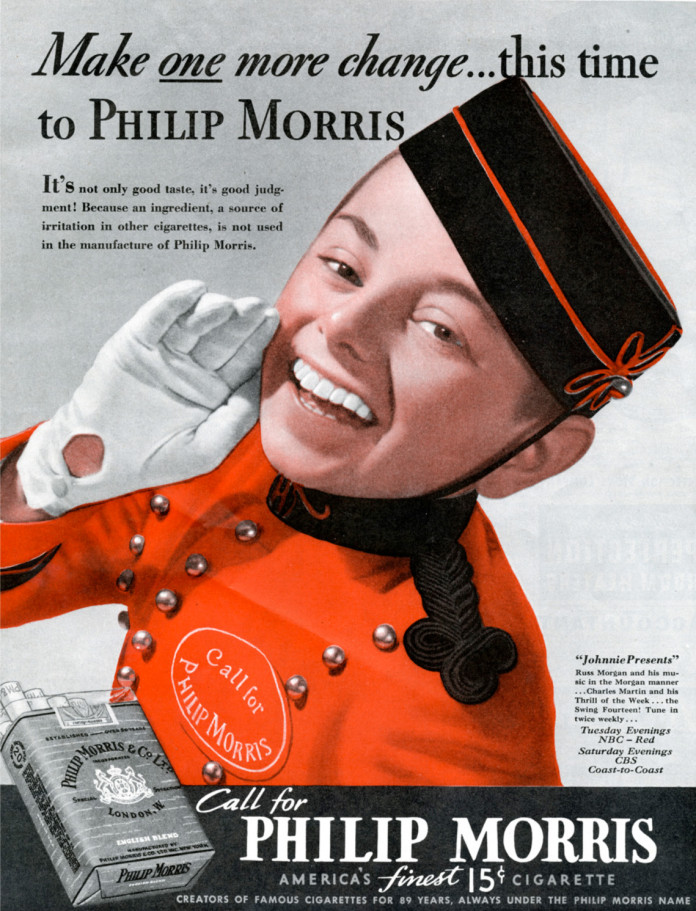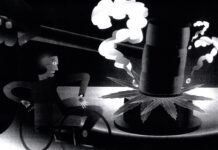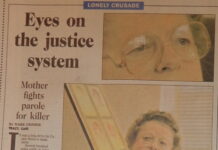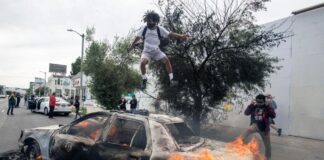
One Party rule in Sacramento drives more nails into Big Tobacco’s California coffin—or does it? The Nattering Nabobs of the Nanny State would like to thank you for smoking
Mark Cromer has a light
Standing outside on the second-floor deck of Windows On The Water in Morro Bay one lush evening last week, I did something risky not only for my health but my standing in the increasingly socio-politically correct Golden State today: I lit up a smoke.
Not a joint, but a cigarette.
Granted, I was alone on the deck and it appeared to remain the unofficial ‘smoking section’ of the upscale restaurant—there was a commercial-grade ashtray in the corner—but my guilty pleasure of enjoying a cigarette with a cocktail now seems destined to be outlawed completely in The People’s Republic of California. The helicopter parents swarming in the larded hive that is Sacramento’s statehouse are always looking for more laws to pass to more effectively control, er, ‘govern’ how the state’s residents conduct their personal lives have sent to the desk of Governor Jerry Brown some of the most sweeping ‘anti-tobacco’ legislation in the nation.
The press has focused on the money that’s motivating the measure, namely a $2-a-pack tax, which will raise the state’s take to $2.87 for every pack of cigarettes sold in California, and it also gives the county seats of power across the state the authority to saddle cigarettes with their own levies. The revenue raised by the new tax if Brown signs it into law will be as high as $1.3 billion annually, according to the state’s legislative analyst, with the money to be “used for healthcare expenses, tobacco-related prevention and cessation programs, law enforcement programs and medical research on tobacco-related diseases.”
Uh-huh. Sure.
Anyone who believes that can then also take comfort in knowing that California’s nearly 40-cents a gallon excise tax on gasoline, which falls on top of the state’s sales tax and its cap-and-trade tax on gasoline, all of which is slapped on the nearly 18.5-cents of Uncle Sam’s own vig-on-the-gallon, is spent judiciously and as advertised on the repair and upkeep of the state’s roadways. Well, at least until they drive them.
For every gallon of gas pumped at the station, consumers are hit with nearly a $1 in taxes, among the highest in the nation, and then pull out onto a network of roadways that are cratered, cracked and in collapse. A recent report out of the California State Senate identified $135 billion in unfunded repairs the state needs to make to its roadways over the coming decade. Those are just the repairs they’ve acknowledged need to be made that they don’t have the scratch for—yet. But not to worry, the state plans to jack up vehicle registration fees and further raise taxes on gasoline by at least another 12-cents-per-gallon.
In the midst of the lowest per-barrel oil prices seen in decades around the globe California still has the highest fixed costs on fuel in the country, which is why it costs a $1.72 for a gallon of gas in New Jersey, but still nearly $3 for a gallon of the same fuel in California. And that is never going to change, but rather it will only get worse as Sacramento turns to ever more creative financing schemes for our sunny state’s long-running going away party.
No, for all its proud declarations about covering health care costs, improving the health of its residents and protecting children from the evil nicotine peddlers of Big Tobacco, Sacramento is transparently desperate for more money. It’s one of the few things about the state’s operational priorities that’s not opaque.
It’s all about the Benjamins.
If legislators were seriously pursuing it from a public health perspective, they’d demand Washington grant regulatory authority over nicotine to the Federal Drug Administration, a move that would spell certain doom for mass legal cigarette sales in the United States. In the face of the perpetual state of inertia that prevails in D.C., California could raise taxes on cigarettes to $10-per-pack and force a showdown in the courts, Capitol Hill and The White House. California has been willing to do just that on issues ranging from gay marriage to driver’s licenses for illegal immigrants to gun control measures and other hot-button social issues throughout the years.
But Sacramento is not serious about pursuing cigarettes as a matter of public health policy and that’s why they are trying to carefully calibrate their tax increase on cigarettes to reach that sweet spot that produces a windfall of annual revenue without driving too many smokers to quit or, more likely, into the underground of black market tobacco and untaxed cigarettes.
The cynicism of their double-game knows few boundaries beyond the bottom line however, and the suits of Sacramento, led by the Nattering Nabobs of the Nanny State (apologies to Spiro Agnew) are happy to take every opportunity to further legislate their reach into our lives and literally our homes, as the new package of tobacco legislation demonstrates.
Another element of the legislative package raises the age of smoking to 21-years-old, with an exemption for the teenagers serving in our military. So apparently Sacramento is able to keep a straight face when declaring an EMT or a police cadet or a college student or an industrial welder or a hairstylist has less rights between the age of 18 and 21 than G.I. Joe & Jane. Good to know.
For a guy who was born at the end of the Baby Boom, the surreal evolution of smoking in California has been fascinating to live through. I didn’t start smoking until I was 30, a late-arrival to lighting up over a drink well after I had become fully informed on all the health risks and I made a conscious adult decision that I didn’t care. A fellow writer and friend in LA remarked “You didn’t start smoking until you were 30? In that case, knock yourself out. By the time it catches up with you Cromer, you’ll already be floating away to Valhalla on the River Vodka.”
My late start to lighting up a cigarette now and again was pretty surprising considering the era I came of age in was a time where cigarettes were everywhere, still a required accessory to the Mad Men couture. I remember in the late 1960s and throughout the 1970s when my parents would take me to dinner parties where coffee tables had ornate cigarette boxes on them filled with loose smokes for the taking and giant sterling silver lighters.
An era when the customary greeting of ‘Can I get you a drink?’ when you were over at someone’s home was immediately followed with ‘Shall we have a smoke?’
My 1963 Ford Falcon had ashtrays in the front dashboard and built into the back seat armrests. It didn’t come with seatbelts, but it did have ashtrays.
At Pomona High School in 1980, there was a designated smoking section for students on campus even though it was against the law for students not yet 18 to smoke at all, which accounted for the vast majority of the campus student body. It was throughout my teenage jobs in the early 1980s that the ‘non-smoking’ sections that had originated in Berkeley in 1977 began to spread like, well, cancer across that state, which was funny to observe the surreal spectacle of a non-smoking section suddenly declared three feet away from the smokers.
Back then the faculty lounge at PHS was filled with smoke and so were my professors’ offices at Cal Poly Pomona, where we had a bar on campus (Cal Poly Pomona was one of the last state universities to have a dedicated bar on campus) where students also lit up. When I first entered the newsrooms in the late 1980s, some of my editors were still smoking in their offices, where the rattle of bottles could be heard when they shut their desk drawers.
There were ashtrays inside the stalls of the shitters in most bars and restaurants. Liquor stores sold singles at the counter for a quarter each or five for a dollar. Djarum cloves could be plucked one-by-one from a jar as well.
You could smoke in fine restaurants, as I remember doing in places such as La Poubelle’s on Franklin Avenue in the late 1990s, or smoking during concerts at every major indoor arena in Southern California.
But even as I was starting to mix cigarettes with my alcohol, the mission creep of what started as smart public policy to provide non-smokers with safe harbors that were smoke free slowly turned into the inexorable tide of intrusion into our lives today. The campus of the high school I attended is now a ‘Tobacco Free Zone,’ the college bar at Cal Poly fell long ago to a chain fast food outlet and the university has adopted “a campus-wide no smoking policy.”
Having a smoke at a table in La Poubelle or inside any other restaurant today would be seen as a greater insult than taking a dump on the table.
When it comes to smoking, California has come a long way, baby.
But Sacramento’s playing to the crowd by publicly ostracizing smoking virtually anywhere outside the bathroom of your own home has provided some darkly comedic moments, as was witnessed recently when State Senator Mark Leno from San Francisco declared “We are doing this…to address a growing health crisis assaulting the children of California.” What’s so obscene about Leno’s using children to grandstand on tobacco restrictions is that he is the very same California legislator who doggedly fought efforts to make possession of child pornography a felony in California—Leno was hell-bent on keeping the horror of ‘kiddie porn’ a misdemeanor offense. Apparently Leno sees an adult smoking a cigarette as a greater menace to the health of children than the dark-web networks of pedophiles that deal in the sexual molestation and emotional murder of children.
The lifestyle interventionists of the Democratic Party that now run Sacramento unimpeded by the residual legislative stain of the Republican Party in California point to studies that purport to show smoking has dropped to all-time lows among the state’s population, including the key demographic of adolescents, as regular smokers generally pick up their habits in their teens. As any analyst can tell you, studies can be very useful in collecting data, but they can also be easily structured to arrive at a desired conclusion. Academics love to turn their stuffy noses up at ‘anecdotal’ information, dismissing it as incomplete snapshots of any issue that provide little context or depth.
But in the real world that most people live in, ‘anecdotal’ evidence is simply the reality of the world around us, the truth of the day-in and day-out, the proverbial facts-on-the-ground that we see with our own eyes.
And one only need to look at the various social weathervanes; from Hollywood movies to music festivals to the areas outside the eateries, bars and clubs to see the reality that smokers, whether pack-a-day regulars or those who like me light up during cocktail hour, haven’t diminished in numbers at all. Like mercury, they’re simply splintering into smaller drops and spreading out to settle wherever they can at the moment, which is really what Sacramento wants.
Standing on the deck at Widows On The Water, I enjoy another epic California sunset over a vodka tonic and a smoke. I know it’s unhealthy and carries risks, just as driving up U.S. Route 101 from LA to Morro Bay was, as I watched young drivers zig-zag through traffic like pinballs while texting at 90-mph. Sacramento doesn’t want to sell them cigarettes but it’s willing to put them behind the wheel of a two-ton Yukon SUV and turn them loose on our highways.
Smoking is dangerous, as is life.
Contemplating that fact, I am always reminded of Jack Nicholson’s great line in The Departed when a bar patron informs him that his mother “Is on her way out.” Nicholson doesn’t miss a beat: “We all are. Act accordingly.”
Indeed we are. And anyway, the closer I get to it the more old age appears to be highly overrated, so I think I’ll have another drink and call for Phillip Morris.










